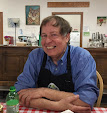Link to Bill himself
has been around the coffeeshop -- and its younger cousin Uptown Bill's
-- for more than 25 years.
He was a part of the coffeeshop staff when Bill himself was in the
place. After Bill's death, Ed was one of the people who stepped in to
keep the coffeeshop running during the discussions of its future.
He stayed at Bill's for nearly a decade after that, until a venture
into his own coffeeshop in 1991. Mr. Ed's Coffeeshop opened in 1991 at
the International Center. That venture lasted until 1994. There were
too many steps and not enough customers, says Ed.
He returned to original Bill's after Mr. Ed's closed and remained a
fixture in the coffeeshop until Uptown Bill's Small Mall opened on
Gilbert Street in 2000. By that time, Ed had created a small business
called Mr. Ed's Supergraphics.
That venture flourished in the new small mall. Flyers and businesses
cards are his main items, along with T-shirt designs. The business
also includes making copies and a fax service.
Ed has been in a wheelchair for many years because of cerebral palsy.
Officially, it's an abnormality of the brain that interferes with the
normal function of the muscles, explains Ed.
"My own term for cerebral palsy is 'physical pest,'" he says. If I
drive a car, I can't control my hands and feet at the same. If I try
to hold a glass of milk, my hand sometimes is jerky and I spill it on
the floor." Ed has taken these and other observations and woven them
into an essay called, of course, "The physical pest."
For some years, Ed lived in a downtown building which had been the
home of the Iowa City Press Citizen when it was part of the
family-owned Speidel Newspapers. The building had been remodeled into
accessible apartments when the newspaper moved out to the edge of town.
Ed has been a well-known part of the downtown scene, whizzing back and
forth from original Bill's (and now Uptown Bill's) in his electric
wheelchair. He runs a variety of errands for the coffeeshop.
A few years ago, Ed became a homeowner. He owns a new home on B
Street, a demonstration project in accessibility. Local builders, the
city of Iowa City and other organizations collaborated on the home. It
features a sink which raises and lowers, a "roll-in" shower and an
oven door which opens from side to side instead of up and down. These
and other features, called "universal design," are designed for
individuals who use wheelchairs.
Most days Ed can be found in his office at the back of the small mall,
adjacent to the Mad Hatter performance space. If you walk by on Court
Street, you can wave to him through the window as you pass. Better
yet, stop in and say hi.
